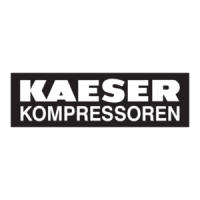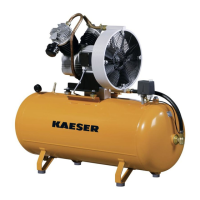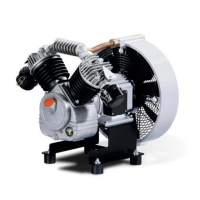Do you have a question about the KAESER EPC 750-2-500 and is the answer not in the manual?
Technical specifications for the compressor block, including displacement and cylinder count.
Recommends standard and special oils for the compressor and their applications.
Details power supply requirements, including voltage, frequency, and connection details.
Lists improper uses of the machine that can lead to danger or damage.
Outlines the responsibilities of the user for safe operation and maintenance.
Emphasizes observing statutory and accepted regulations during installation and operation.
Defines the qualifications required for authorized operators and personnel.
Highlights adherence to inspection schedules and accident prevention regulations.
Provides information on various dangers that can arise during machine operation.
Describes how to safely deal with dangers from electricity, compression, air quality, etc.
Provides information on safe conduct when handling the machine.
Explains the function of safety devices and the importance of not altering them.
Shows the location and meaning of various safety signs on the machine.
Provides instructions for emergency situations like fire fighting and first aid.
Describes operating modes (LOAD, STANDSTILL) and control modes (Pressure switch).
Lists safety devices provided and states they must not be modified.
Safety precautions during installation, including fire prevention and explosion protection.
Requirements for machine installation, including location and clearances.
Basic safety instructions for machine installation and start-up.
Procedure for connecting the machine to the compressed air network.
Instructions for connecting the machine to the power supply by authorized personnel.
Safety instructions for safe initial start-up of the machine.
Checklist of installation and operating conditions before first start-up.
Ensures the motor is operated with a correctly adjusted overload protection switch.
Steps for starting the machine for the first time and initial checks.
Explains how to set the network working pressure to suit operating conditions.
Details how to adjust the pressure regulator to maintain constant working pressure.
Instructions for switching the machine on and off using the ON/OFF switch.
Lists common faults, their possible causes, and suggested remedies.
Safety precautions to ensure safe machine maintenance.
Provides recommended maintenance intervals for average operating conditions.
Lists regular maintenance tasks and their corresponding intervals.
Lists regular service tasks to be carried out by authorized KAESER Service Technicians.
Procedure for topping up compressor oil, including cautions on oil types.
Details the process for draining and refilling the compressor oil.
Explains how to test pressure relief valves to prevent sticking.
Prevents relief valve sticking by activating at regular intervals.
Prevents relief valve sticking by activating at regular intervals.
Procedure for venting the machine to remove pressure before maintenance.
Describes the ECO-Drain automatic condensate drain system.
| Model | EPC 750-2-500 |
|---|---|
| Max Pressure | 10 bar |
| Free Air Delivery | 750 l/min |
| Motor Power | 5.5 kW |
| Voltage | 400 V |
| Frequency | 50 Hz |
| Tank capacity | 500 l |











